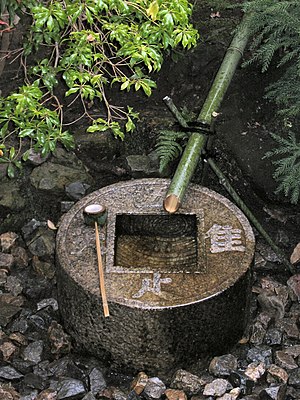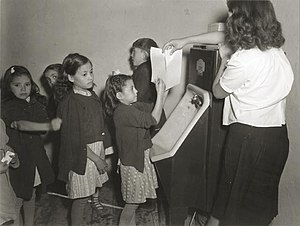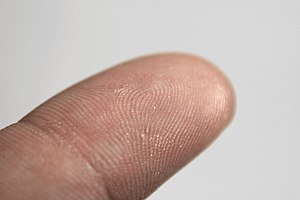AY Honors/Home Nursing/Answer Key
Hand washing is the act of cleansing the hands with water or another liquid, with or without the use of soap or other detergents, for the sanitary purpose of removing soil and/or microorganisms.
Purpose
The main purpose of washing hands is to cleanse the hands of pathogens (including bacteria or viruses) and chemicals which can cause personal harm or disease. This is especially important for people who handle food or work in the medical field. The Centers for Disease Control and Prevention (CDC) has stated that "It is well-documented that the most important measure for preventing the spread of pathogens is effective handwashing."
While hot water may more effectively clean your hands, this is primarily due to its increased capability as a solvent, and not due to hot water actually killing germs. Hot water is more effective at removing dirt, oils and/or chemicals, but contrary to popular belief, it does not kill microorganisms. A temperature that is comfortable for hand washing (about Template:Convert) is not nearly hot enough to kill any microorganism. It would take more than double that temperature to effectively kill germs (typically Template:Convert).
Personal hand washing
To maintain good hygiene, hands should always be washed after using the toilet, changing a diaper, tending to someone who is sick, or handling raw meat, fish, or poultry. Hands should also be washed before eating, handling or cooking food. Conventionally, the use of soap and warm running water and the washing of all surfaces thoroughly, including under fingernails is seen as necessary. One should rub wet, soapy hands together outside the stream of running water for at least 20 seconds, before rinsing thoroughly and then drying with a clean or disposable towel.& After drying, a dry paper towel should be used to turn off the water (and open the exit door if one is in a restroom or other separate room). Moisturizing lotion is often recommended to keep the hands from drying out, should one's hands require washing more than a few times per day.&
Antibacterial soaps have been heavily promoted to a health-conscious public. To date, there is no evidence that using recommended antiseptics or disinfectants selects for antibiotic-resistant organisms in nature.& However, antibacterial soaps contain common antibacterial agents such as Triclosan, which has an extensive list of resistant strains of organisms. So, even if antibacterial soaps do not select for antibiotic resistant strains, they might not be as effective as they are marketed to be. These soaps are quite different from the non-water-based hand hygiene agents referred to below, which also do not promote antibiotic resistance.&
Truths, myths, and misinformation
- Washing your hands with soap and water kills germs
- This is misinformation
Plain soaps have minimal if any antimicrobial activity. In several clinical studies, hand washing with plain soap failed to remove bad microorganisms (pathogens) from the hands of hospital personnel. Hand washing with plain soap can result in an increase in bacterial counts on the skin. Occasionally, contaminated plain soaps have colonized hands with Gram-negative bacteria.&
- Killing germs on your hands decreases your immunity
- This is a myth
The skin on your body is covered with microorganisms. Our environment is contaminated with good and bad microorganisms. You cannot kill all of the microorganisms on your hands. Your large intestine contains large numbers of microorganisms. All of these sources of germs stimulate your immune response. CDC guidelines for health care workers call for alcohol rubs to be used 60 or more times a day between patients and after touching contaminated surfaces. Killing germs on your hands will not decrease your immunity but it will help prevent disease.&
- Alcohol rub hand sanitizers do not kill germs
- This is misinformation
Hand sanitizers containing a minimum of 60 to 95% alcohol are very efficient germ killers. Alcohol rub sanitizers kill bacteria, multi-drug resistant bacteria (MRSA and VRE), tuberculosis, and viruses (including HIV, herpes, RSV, rhinovirus, vaccinia, influenza, and hepatitis) and fungus. Alcohol rub sanitizers containing 70% alcohol kill 3.5 log10 (99.9%) of the bacteria on hands 30 seconds after application and 4 to 5 log10 (99.99 to 99.999%) of the bacteria on hands 1 minute after application. Alcohol rub sanitizers can prevent the transfer of health-care associated pathogens (Gram-negative bacteria) better than soap and water. Alcohol rub sanitizers are not appropriate for use when your hands are visibly dirty, soiled or contaminated with blood. Use soap and water for dirty or soiled hands.&
- Don’t kill the good germs — the good germs protect our hands from the bad germs
- This is a myth
Good germs are microorganisms normally found on human skin and bad germs are pathogenic (disease producing) microorganisms. The numbers of good germs and bad germs on the hands are variable from one person to the next but remain relatively constant for each individual. Good germs cannot protect you against bad germs. Anyone can become contaminated with bad germs (pathogens). Bad germs (pathogens) do not always cause disease and good germs can, under the right conditions, cause disease.&&
- Alcohol will dissolve the natural oils on your skin and cause dry skin
- This is true
Frequent use of alcohol-based formulations for hand sanitizers can cause dry skin unless emollients and/or skin moisturizers are added to the formula. The drying effect of alcohol can be reduced or eliminated by adding glycerin and/or other emollients to the formula. In several prospective clinical trials, alcohol based hand sanitizers containing emollients caused substantially less skin irritation and dryness than soaps or antimicrobial detergents. Allergic contact dermatitis, contact urticaria syndrome or hypersensitivity to alcohol or additives present in alcohol hand rubs rarely occurs.&&
- Alcohol rubs cause (bacterial) mutation and resistance
- This is misinformation
Dead microorganisms don’t mutate. Alcohol rubs (biocides) kill microorganisms. Current scientific evidence has not shown a link exists between the use of topical antimicrobial formulations and antiseptic or antibiotic resistance. Antiseptics (biocides) have multiple (thousands) of nonspecific killing sites on and in the microbial cell which cannot easily mutate. Antibiotics and antibacterial soaps (triclosan) have one very specific killing site on and in the microbial cell which can easily mutate. Antibiotic resistance has no effect on the effectiveness of antiseptics.&&
- Alcohol rub and combination hand sanitizers kill germs better than soap and water
- This is true
Alcohol rubs and combination hand sanitizers are effective at killing germs on your hands, but not effective at removing dirt. Conversely, soap and water are very effective at cleaning dirty or soiled hands, but are not good at killing germs (as discussed above).&
- Alcohol rubs with two germ killers are significantly more effective germ killers than alcohol rubs with one germ killer
- This is true
Many clinical studies have shown that alcohol rubs containing two germ killers (ie. Alcohol and Chlorhexidine gluconate or Benzalkonium chloride) are significantly better germ killers than alcohol rubs containing alcohol alone.&
Hand washing as compensation
Excessive hand washing is commonly seen as a symptom of obsessive-compulsive disorder (OCD).
It has also been found that people, after having recalled or contemplated unethical acts, tend to wash hands more often than others, and tend to value hand washing equipment more. Furthermore, those who are allowed to wash their hands after such a contemplation are less likely to engage in other "cleansing" compensatory actions, such as volunteering.&&
Symbolic hand washing

Ritual handwashing is a feature of many religions, including Bahá'í Faith, Hinduism and tevilah and netilat yadayim in Judaism. Similar to these are the practises of Lavabo in Christianity, Wudu in Islam and Misogi in Shintō.
Idioms
When someone "washes their hands of" something, this means that they are declaring their unwillingness to take responsibility for it or share complicity in it. Matthew 27:24 gives an account of Pontius Pilate washing his hands of the decision to crucify Jesus: "When Pilate saw that he could prevail nothing, but that rather a tumult was made, he took water, and washed his hands before the multitude, saying, I am innocent of the blood of this just person: see ye to it."
See also
References
- ↑ Hand washing from Mayo Clinic
- ↑ Hand washing from Tufts University
- ↑ Template:Cite journal
- ↑ Clean hands from the CDC
- ↑ 5.0 5.1 5.2 5.3 "Hand Hygiene for Healthcare Workers". LearnWell Resources, Inc, a California nonprofit public benefit 501(c)(3) corporation. http://www.learnwell.org//handhygiene.htm. Retrieved 2007-04-27.
- ↑ Template:Cite journal
- ↑ Template:Cite journal
- ↑ 8.0 8.1 Template:Cite journal
- ↑ Template:Cite journal
- ↑ Template:Cite journal
- ↑ "Alcohol Hand Rub and Hand Hygiene". Clinical Excellence Commission, Health, New South Wales, Australia. http://www.cec.health.nsw.gov.au/pdf/AlcoholHandRub061013.pdf. Retrieved 2007-04-27.
- ↑ Benedict Carey. Lady Macbeth Not Alone in Her Quest for Spotlessness. The New York Times, 12 September 2006
- ↑ Template:Cite journal
External links
de:Händedesinfektion fr:Hygiène des mains ja:手洗い simple:Hand washing sv:Handtvagning


